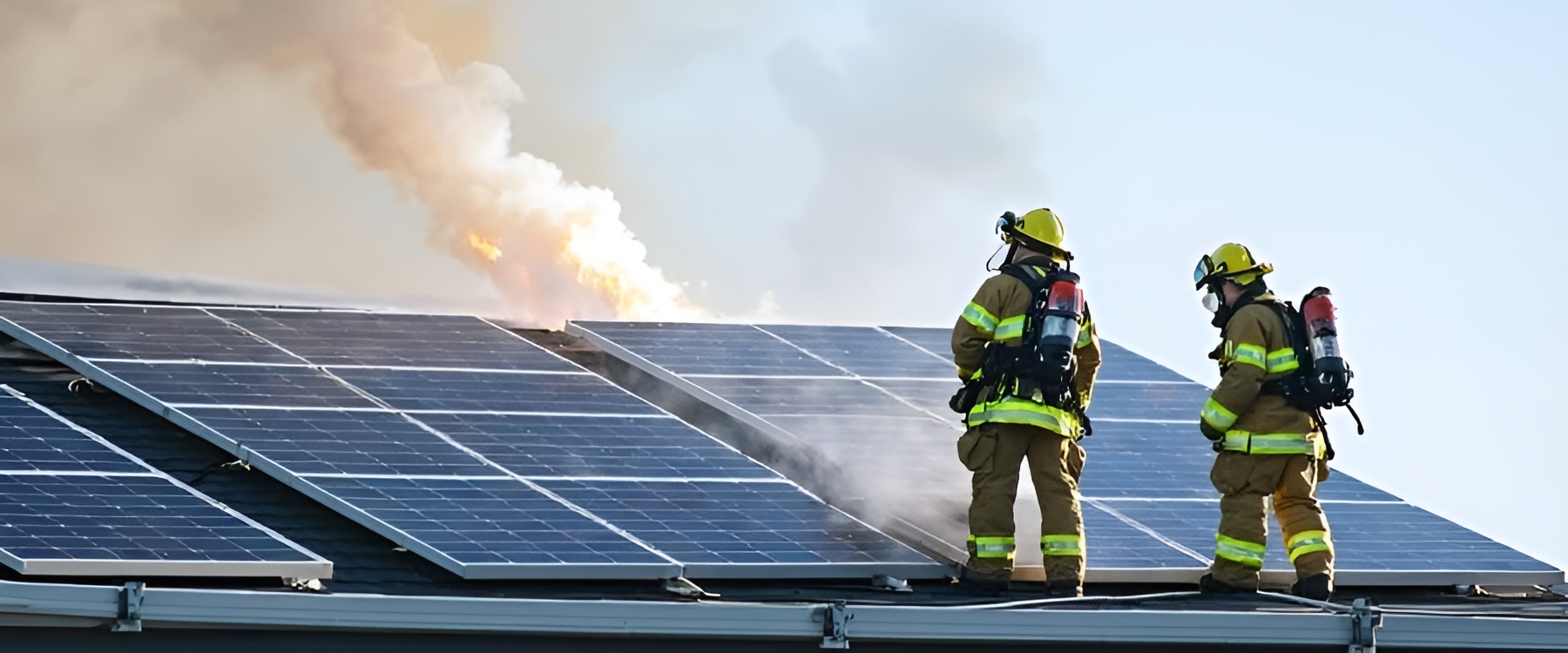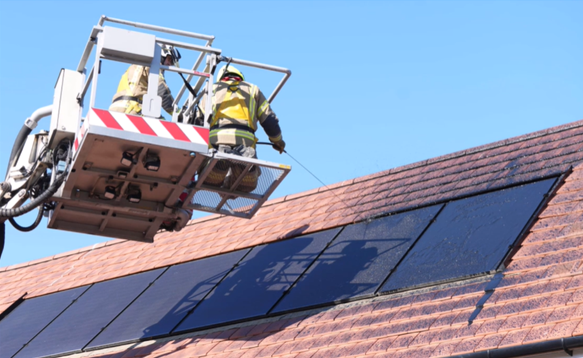
As the movement towards renewable energy gains momentum, Jim Foran looks at the potential serious and unmitigated electrical safety risk posed by solar panel fires.
Photovoltaic (PV) systems, commonly known as solar panel systems, are a growing challenge for first responders, including fire and emergency services personnel as well as electrical contractors. Whether responding to a solar panel fire, a fire at a structure featuring solar panels, attending to storm damage, or encountering a property that has a faulty or substandard solar system installed, solar panels pose a serious risk to safety due to their capacity to produce potentially lethal amounts of DC electricity as long as the solar PV system is exposed to light.
Solar panel systems are emerging as a new and growing incident category, yet current standard operating procedures (SOPs) still do not adequately address the increasingly obvious safety gaps. Fire and emergency service crews are likely to face solar panel incidents on a daily basis in the near future, but without adequate tools, procedures, or training, dangerous scenarios may become more common and increasingly put lives at risk.
Government figures confirm that the use of solar PV to generate electricity in the UK has grown rapidly since 2010, increasing capacity from 95 MW to 14,900 MW (14.9GW) at the end of March 2023. There are now over 1.2 million solar PV installations in the UK which accounts for approximately 5% of total electricity generation in the UK.
With rising energy prices, interest in solar PV installations is growing exponentially, especially as householders emerge from fixed-rate energy deals to the shock of record-breaking energy price increases.
The rules governing solar PV safety
As detailed by the National Building Specification (NBS), the current safety requirements include several standards that PV products should comply with (BS EN 61730-1, BS EN 61215, BS EN 61646, MCS 0065), and include – amongst other factors – requirements that address fire hazards. The Microgeneration Certification Scheme (MCS) provides building owners with a measure of confidence in the installers and products used.
Furthermore, PV systems that form part of the roof structure should satisfy a fire exposure test, e.g., DD CEN/TS 1187 test 4 or BS 476-3. This test seeks to ensure that fire will not spread between buildings via the roofs.
Alongside the above standards, the FPA has recently published RC62 Recommendations for fire safety with PV panel installations. Developed as a Joint Code of Practice by RISCAuthority and the MCS, with the support of Solar Energy UK, the primary focus of this document is the prevention and mitigation of fires involving PV systems. The Code applies to all stages of a project: planning, procurement, design, installation, operation, and maintenance. With the exception of some niche applications, the scope relates to roof-top installations on commercial and multi-residential buildings up to and including larger utility-scale projects. While commercial
ground-mounted PV systems are not covered in detail in the guide, the risk control principles discussed are similar.
The risks related to solar panels
Notwithstanding these regimes for installers and products, there is currently no national UK guidance specific to fighting fires involving PV systems, despite PV systems presenting new risks to firefighters, especially from the risk of electric shock and electrocution. However, the BRE National Solar Centre has carried out some in-depth analysis of the causes and challenges of solar PV fires as uncovered by previous incidents in the UK.
As outlined in the BRE Report, Fire and Solar PV Systems, it is difficult to locate accurate data and statistics relating to solar panel fire incidents in the UK, with the same true for most countries around the world.
Currently, there is no reporting field for solar panels in the UK national incident reporting system, which makes it impossible to measure the true impact that solar panels have upon national fire incident data or firefighter safety. If it cannot be measured, it cannot be managed, and for this reason it is critical that this data gap is recognised and addressed without delay, and that a reporting field for solar PV systems be added to the national incident reporting system so that stakeholders have the right information to make evidence-based decisions rather than opinion-based decisions which are the status quo of today. There is no doubt that the true statistics on incidents involving solar panels are significantly under-reported and the true costs in terms of property damage, revenue loss, and work health and safety liabilities are yet to be determined and accurately measured.
The DC Danger Zone
The primary risks associated with solar panels are electric shock and electrocution. As long as solar panels are exposed to light, they will continue to produce potentially lethal amounts of direct current (DC) electricity, known within the industry as the ‘DC Danger Zone’. This means anyone operating near a solar panel system during daylight hours is always engaging with live electrical equipment.
To put the risk of solar panels into perspective, a domestic 230-volt AC power outlet is usually rated at 10 amps and provides 2,300 watts of power. The average size of a residential solar PV installation in the UK is 4 kilowatts, usually configured in multiple strings of up to 600 volts per string. With up to 10 amps available, the average residential solar PV array can produce up to 4,000 watts of power. Residential installations of up to 10 kilowatts are now common, while commercial installations can be upward of several hundred kilowatts, and generation plants can exceed 100 megawatts or more. Even small domestic systems have the capacity to injure via electric shock and kill by electrocution. The physiological impacts from 600V DC current exposure can be represented as follows:
| Physiological effect | DC threshold limit for adult (milliamps) |
| Mild shock reaction | 2 mA |
| Lock on | 40 mA |
| Electrical burns | 70 mA |
| Ventricular fibrillation | 240 mA |
Better training and equipment needed
One of the challenges surrounding solar panel safety is the simple fact that the technology is relatively new and has grown so quickly. There are very few true experts in the field of solar safety and authorities are only just starting to recognise the education and safety gaps. Because of this, emergency service personnel are at risk of making fatal errors on the job.
For example, the practice of tarping damaged solar panels is extremely dangerous and operates in clear breach of standard operating procedures (SOPs), which state that crews should assume the solar power system and surrounding area is live. SOPs mandate an exclusion zone of at least three metres be established around any damaged solar panel components, and the exclusion zone be increased to eight metres if the components are in contact with conductive materials. Tarping solar panels is an outdated but persistent practice that is done with good intentions, but is ultimately a dangerous solution.
Read our FAQ section
The full scope of solar panel risk
Sandwiched between the protective glass, frame, and back-sheet of the solar panel, solar cells present no risk to health, but once a panel burns and the solar cells are exposed, the burning panels can be highly toxic and dangerous to humans and the environment. Solar cells contain carcinogens, cadmium telluride and gallium arsenide, as well as potentially lethal phosphorous. Inhalation of these toxic nano-particles cause silicosis of the lungs and should be treated with the same precautions as asbestos. Self-contained breathing apparatus (SCBA) should always be utilised in incidents involving burning solar panels.
With solar panels now being installed on an ever-growing number of homes and businesses across the UK, it is important to consider the broader range of incidents involving structures and fire. For every incident initiating from a fault in the solar panel system, there are many more where the ignition point is totally unrelated, but where the fire may encroach upon the solar panel system and compromise safety. In these scenarios, it is just as important to isolate the power from the solar panel system as it is to isolate mains power from the grid. Up until now this has proven problematic for firefighters and in many cases defensive tactics have been employed because solar panel systems could not be easily or reliably isolated, increasing property damage and insurance claim costs at properties featuring solar panel systems.
Solar safety technologies
There are a range of electro-mechanical solutions available on the market including isolation switches, micro-inverter systems, and DC optimizing equipment (broadly described as ‘rapid shutdown’ technologies), but all of these options operate downstream of the panels and do not isolate the power produced by the panel itself.
An Australian innovation, PVSTOP, has recently been developed and is now used by a growing number of local and international fire and emergency services agencies to safely isolate the power produced by solar PV systems. PVSTOP acts as a ‘liquid tarp’ that can be sprayed on to solar panels to block light, forming a waterproof film which isolates the power produced by the system in seconds and eliminates the risk of high voltage DC electrocution. It has been independently tested and verified as effective in reducing DC current to safe levels with as little as 40% coverage across the solar panels, it is also non-toxic, environmentally safe and post-incident, it can simply be peeled off the solar panels without causing any damage to the system.
Having undergone comprehensive testing, accreditation, and operational trials in a number of countries, PVSTOP is now standard equipment with a number of the world’s largest and most innovative Fire Departments including the London Fire Brigade (LFB), the New York Fire Department (FDNY), and the Singapore Civil Defence Force (SCDF). This innovation is just one example of the industry’s step toward adapting to more environmentally friendly practices and products that do not limit our ability to embrace clean energy solutions. When carried on first response appliances, it can mitigate DC electrical risk from solar systems allowing for offensive firefighting operations to continue rather than incident commanders having to revert to more defensive strategies.
Learning from the lessons of the past
Solar PV systems are no longer an emerging technology, they are a mainstream energy source and recent history shows us that safety is lagging well behind the exponential growth of the industry. Critical to improving this situation is better statistical data/reporting, better education and training, and new tools that have been specifically designed to mitigate the risks associated with solar PV technology.
Energy storage systems, electric vehicles, EV charging stations, and built-in photovoltaics represent the latest developments in new technology, a technology which is upon us now. They represent a new and exciting industrial revolution, but they also represent significant safety risks for first responders, system owners and maintainers, and broader society.
The future requires effective leadership that is innovative, forward thinking and can navigate bureaucracy to reach effective strategic outcomes. If we focus on effective safety objectives, the future will be bright, clean, and safe, but if we continue to operate in the status quo, history will repeat and we will continue to walk head-long into unanticipated risks.
Jim Foran is the Director and CEO of PVSTOP International Pty Ltd.


